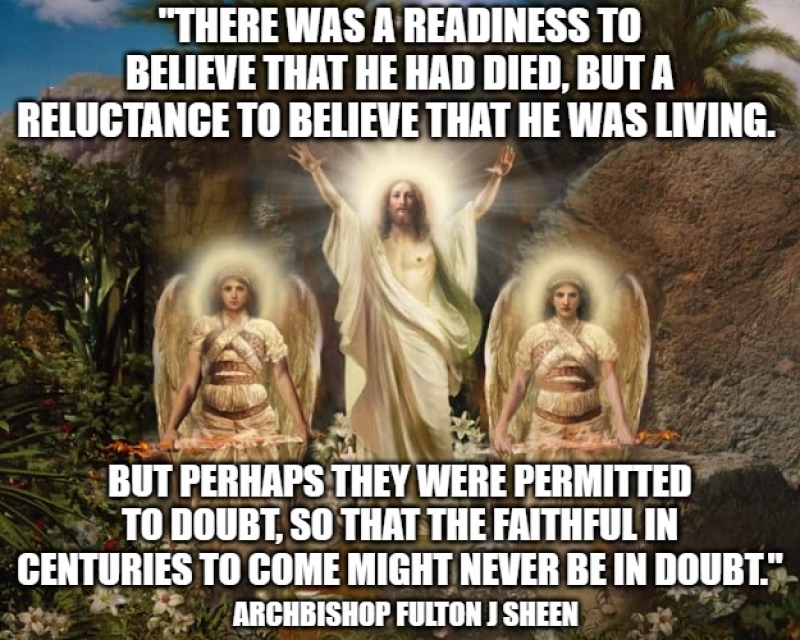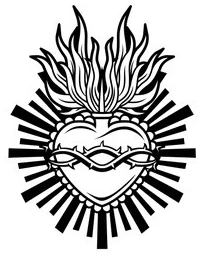Easter Sunday (Year A) - 9 April
9th April 2023

Easter Sunday (Year A) - 9 April
“But now that the Saviour has raised His body, death is no longer terrible, but all those who believe in Christ tread it underfoot as nothing, and prefer to die rather than to deny their faith in Christ, knowing full well that when they die they do not perish, but live indeed, and become incorruptible through the Resurrection.” - St Athanasius the Great
A reflection on the Resurrection of Christ by the Venerable Archbishop Fulton J Sheen:
"In the dim dawn of Sunday morning several women were seen approaching the tomb. The very fact that the women brought spices proved that they did not expect a Resurrection. It seemed strange that such should have been the case after the many references by Our Lord to His death and His Resurrection. But evidently the disciples as well as the women, whenever He predicted His Passion, seemed to remember more His death than His Resurrection. It never occurred to them as a possible thing; it was foreign to their thoughts. When the stone was rolled to the door of the sepulchre, not only was Christ buried but also all of their hopes. The only thought the women had was to anoint the body of the dead Christ—an act that was born of despairing and as yet unbelieving love.
"‘No need to be dismayed; You have come to look for Jesus of Nazareth, Who was crucified; He has risen again; He is not here’ (Mark 16:6). The angel’s words were the first Gospel preached after the Resurrection, and it is the one that went back to His Passion, for the angel spoke of Him, as ‘Jesus of Nazareth Who was crucified.’ These words conveyed the name of His humanity, the humility of His dwelling place, and the ignominy of His death; in all three, lowliness, ignominy, and shame are brought in comparison with His rising from the dead. Bethlehem, Nazareth, and Jerusalem are all made the identifying marks of His Resurrection.
"The Lord now began the first of His eleven recorded appearances between His Resurrection and Ascension: sometimes to His Apostles, at other times to five hundred brethren at once, at some other times to the women. The first appearance was to Mary Magdalen.
"Only purity and sinlessness could welcome the all holy Son of God into the world; hence, Mary Immaculate met Him at the door of earth in the city of Bethlehem. But only a repentant sinner, who had herself risen from the grave of sin to the newness of life in God, could fittingly understand the triumph over sin. To the honour of womanhood it must forever be said: A woman was closest to the Cross on Good Friday, and first at the tomb on Easter Morn.
"Mary was always at His feet. She was there as she anointed Him for burial; she was there as she stood at the Cross; now in joy at seeing the Master, she threw herself at His feet to embrace them. But He said to her with a restraining gesture: ‘Do not cling to Me thus; I have not yet gone up to My Father’s side’ (John 20:17). Her tender tokens of affection were directed to Him more as the Son of Man than as the Son of God. Hence He bade her not to touch Him. He said to her: ‘Return to My brethren and tell them this; I am going up to Him Who is My Father and your Father Who is My God and your God’ (John 20:17). This was the first time He ever called His Apostles ‘My Brethren.’ Before man could be an adopted son of God, he had to be redeemed from enmity with God. He took the Crucifixion to multiply His Sonship into other sons of God. But there would be a vast difference between Himself as the natural Son and human beings, who through His Spirit would become the adopted sons. Hence, as always, He made a rigid distinction between 'My Father' and 'Your Father.' Never once in His life did He say 'Our Father' as if the relationship were the same between Himself and men; His relation to the Father was unique and incommunicable; Sonship was by nature His; only by grace and adoption were men sons of God.
"Obediently, Mary Magdalen hastened to the disciples who were ‘mourning and weeping.’ She told them she had seen the Lord and the words He had spoken to her. What reception did her tidings receive? Once again, scepticism, doubt, and unbelief. Eve believed the serpent; but the disciples did not believe the Son of God. As for Mary Magdalen and any other woman who might tell of His Resurrection: ‘To their minds the story seemed madness, and they could not believe it’ (Luke 24:11).
"It was a forecast of the way the world would receive the news of Redemption. Mary Magdalen and the other women did not at first believe in the Resurrection; they had to be convinced. Neither did the Apostles believe. Their answer was 'You know women! Always imagining things.' Long before the advent of scientific psychology, people were afraid of their minds playing tricks on them. Modern incredulity in the face of the extraordinary is nothing compared to the scepticism which immediately greeted the first news of the Resurrection. What modern sceptics say about the Resurrection story, the disciples themselves were the first to say, namely, it was an idle tale. As the original agnostics of Christianity, with one assent the Apostles dismissed the whole story as a delusion. Something very extraordinary must happen, and some very concrete evidence must be presented to all of these doubters, before they overcome their reluctance to believe.
"Their scepticism was even more difficult than modern scepticism to overcome, because theirs started from a hope that was seemingly disappointed on Calvary; this was far more difficult to heal than a modern scepticism, which is without hope. Nothing could be further from the truth than to say that the followers of Our Blessed Lord were expecting the Resurrection and, therefore, were ready to believe it or to console themselves for a loss that seemed irreparable. No agnostic has written about the Resurrection anything that Peter and the other Apostles had not already had in their own minds. When Mohammed died, Omar rushed from his tent, sword in hand, and declared that he would kill anyone who said that the Prophet had died. In the case of Christ, there was a readiness to believe that He had died, but a reluctance to believe that He was living. But perhaps they were permitted to doubt, so that the faithful in centuries to come might never be in doubt." (Life of Christ)
Easter Blessing Prayer for Families
Almighty God, who through Your only-begotten Son Jesus Christ overcame death and opened to us the gate of everlasting life: Grant that we, who celebrate with joy the day of the Lord’s resurrection, may be raised from the death of sin by Your life-giving Spirit; through Jesus Christ our Lord, who lives and reigns with You and the Holy Spirit, one God, now and forever. Amen. 🙏💖💐
Food for thought
We have been saved and made righteous in the sight of God through Christ who died and rose again for us. In His Resurrection, Christ revealed His true identity as the eternal Son of God and Lord of the living and the dead. He calls us to become fully configured to Him through our sufferings by sharing in His sufferings, just as His Resurrection gives the promise of the fullness of life we may share with Him in His eternal kingdom if we but do God’s will.


